engine VOLVO S60 2007 Manual PDF
[x] Cancel search | Manufacturer: VOLVO, Model Year: 2007, Model line: S60, Model: VOLVO S60 2007Pages: 200, PDF Size: 4.03 MB
Page 177 of 200
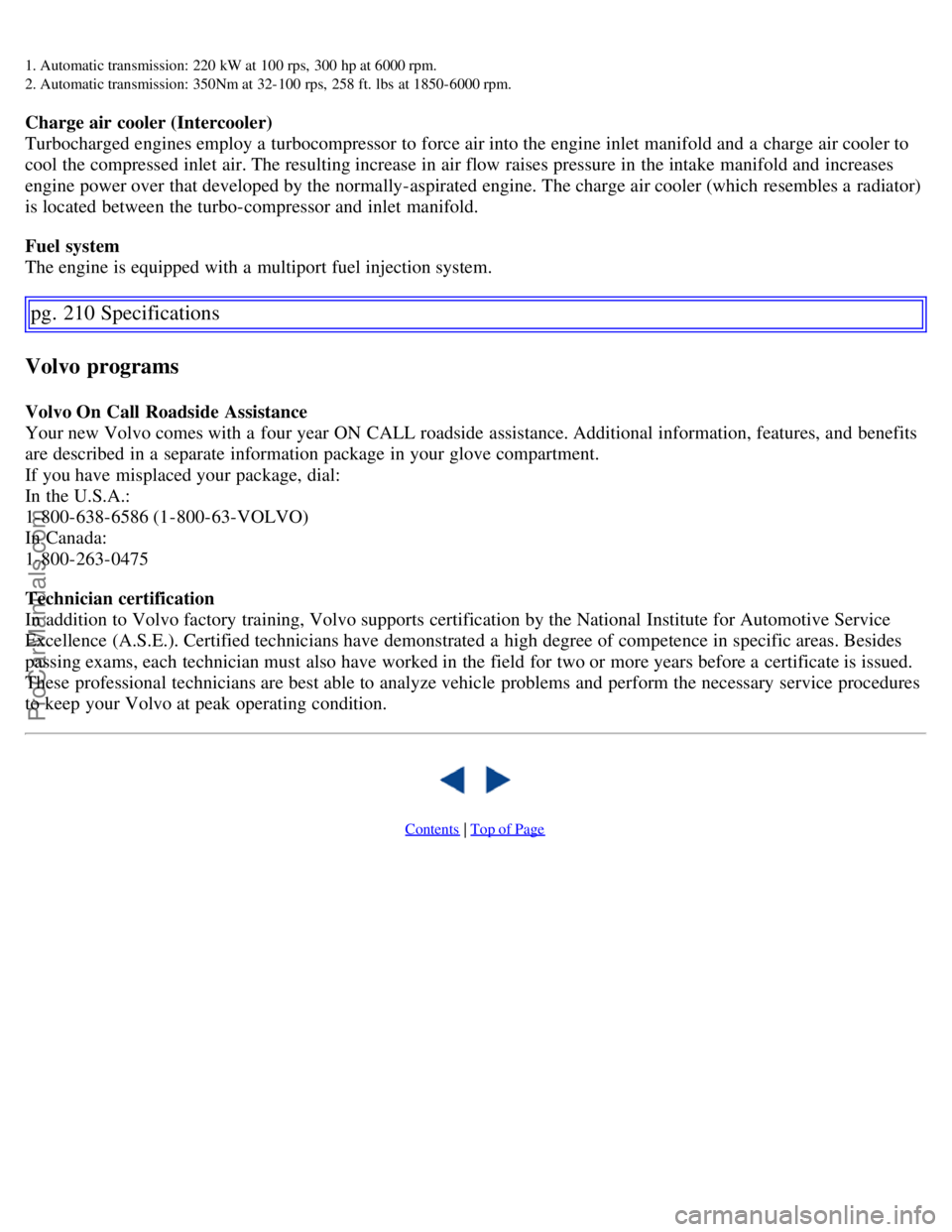
1. Automatic transmission: 220 kW at 100 rps, 300 hp at 6000 rpm.
2. Automatic transmission: 350Nm at 32- 100 rps, 258 ft. lbs at 1850- 6000 rpm.
Charge air cooler (Intercooler)
Turbocharged engines employ a turbocompressor to force air into the engine inlet manifold and a charge air cooler to
cool the compressed inlet air. The resulting increase in air flow raises pressure in the intake manifold and increases
engine power over that developed by the normally-aspirated engine. The charge air cooler (which resembles a radiator)
is located between the turbo-compressor and inlet manifold.
Fuel system
The engine is equipped with a multiport fuel injection system.
pg. 210 Specifications
Volvo programs
Volvo On Call Roadside Assistance
Your new Volvo comes with a four year ON CALL roadside assistance. Additional information, features, and benefits
are described in a separate information package in your glove compartment.
If you have misplaced your package, dial:
In the U.S.A.:
1-800-638-6586 (1-800-63-VOLVO)
In Canada:
1-800-263-0475
Technician certification
In addition to Volvo factory training, Volvo supports certification by the National Institute for Automotive Service
Excellence (A.S.E.). Certified technicians have demonstrated a high degree of competence in specific areas. Besides
passing exams, each technician must also have worked in the field for two or more years before a certificate is issued.
These professional technicians are best able to analyze vehicle problems and perform the necessary service procedures
to keep your Volvo at peak operating condition.
Contents | Top of Page
ProCarManuals.com
Page 191 of 200
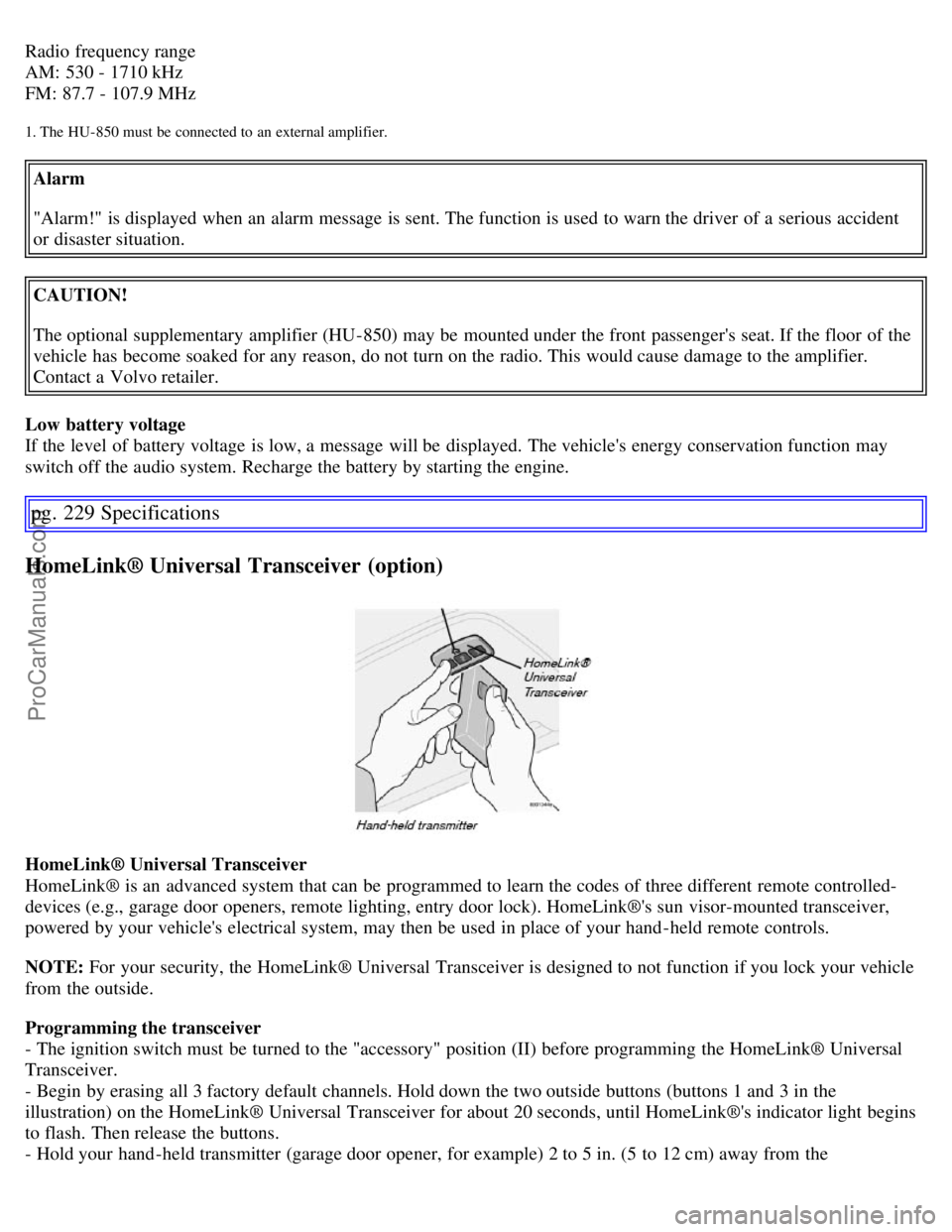
Radio frequency range
AM: 530 - 1710 kHz
FM: 87.7 - 107.9 MHz
1. The HU- 850 must be connected to an external amplifier.
Alarm
"Alarm!" is displayed when an alarm message is sent. The function is used to warn the driver of a serious accident
or disaster situation.
CAUTION!
The optional supplementary amplifier (HU-850) may be mounted under the front passenger's seat. If the floor of the
vehicle has become soaked for any reason, do not turn on the radio. This would cause damage to the amplifier.
Contact a Volvo retailer.
Low battery voltage
If the level of battery voltage is low, a message will be displayed. The vehicle's energy conservation function may
switch off the audio system. Recharge the battery by starting the engine.
pg. 229 Specifications
HomeLink® Universal Transceiver (option)
HomeLink® Universal Transceiver
HomeLink® is an advanced system that can be programmed to learn the codes of three different remote controlled-
devices (e.g., garage door openers, remote lighting, entry door lock). HomeLink®'s sun visor-mounted transceiver,
powered by your vehicle's electrical system, may then be used in place of your hand -held remote controls.
NOTE: For your security, the HomeLink® Universal Transceiver is designed to not function if you lock your vehicle
from the outside.
Programming the transceiver
- The ignition switch must be turned to the "accessory" position (II) before programming the HomeLink® Universal
Transceiver.
- Begin by erasing all 3 factory default channels. Hold down the two outside buttons (buttons 1 and 3 in the
illustration) on the HomeLink® Universal Transceiver for about 20 seconds, until HomeLink®'s indicator light begins
to flash. Then release the buttons.
- Hold your hand -held transmitter (garage door opener, for example) 2 to 5 in. (5 to 12 cm) away from the
ProCarManuals.com
Page 193 of 200
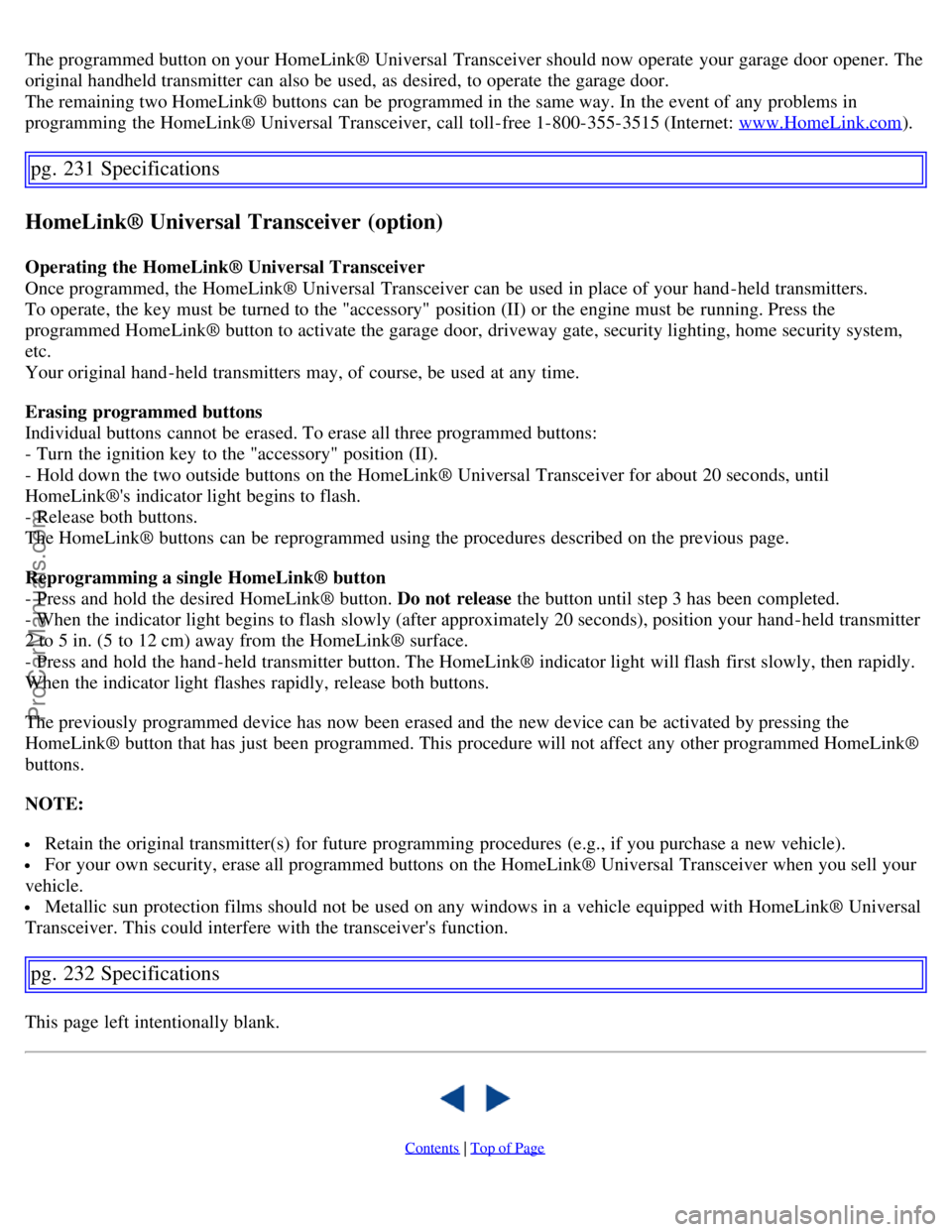
The programmed button on your HomeLink® Universal Transceiver should now operate your garage door opener. The
original handheld transmitter can also be used, as desired, to operate the garage door.
The remaining two HomeLink® buttons can be programmed in the same way. In the event of any problems in
programming the HomeLink® Universal Transceiver, call toll-free 1-800-355-3515 (Internet: www.HomeLink.com
).
pg. 231 Specifications
HomeLink® Universal Transceiver (option)
Operating the HomeLink® Universal Transceiver
Once programmed, the HomeLink® Universal Transceiver can be used in place of your hand -held transmitters.
To operate, the key must be turned to the "accessory" position (II) or the engine must be running. Press the
programmed HomeLink® button to activate the garage door, driveway gate, security lighting, home security system,
etc.
Your original hand -held transmitters may, of course, be used at any time.
Erasing programmed buttons
Individual buttons cannot be erased. To erase all three programmed buttons:
- Turn the ignition key to the "accessory" position (II).
- Hold down the two outside buttons on the HomeLink® Universal Transceiver for about 20 seconds, until
HomeLink®'s indicator light begins to flash.
- Release both buttons.
The HomeLink® buttons can be reprogrammed using the procedures described on the previous page.
Reprogramming a single HomeLink® button
- Press and hold the desired HomeLink® button. Do not release the button until step 3 has been completed.
- When the indicator light begins to flash slowly (after approximately 20 seconds), position your hand -held transmitter
2 to 5 in. (5 to 12 cm) away from the HomeLink® surface.
- Press and hold the hand -held transmitter button. The HomeLink® indicator light will flash first slowly, then rapidly.
When the indicator light flashes rapidly, release both buttons.
The previously programmed device has now been erased and the new device can be activated by pressing the
HomeLink® button that has just been programmed. This procedure will not affect any other programmed HomeLink®
buttons.
NOTE:
Retain the original transmitter(s) for future programming procedures (e.g., if you purchase a new vehicle).
For your own security, erase all programmed buttons on the HomeLink® Universal Transceiver when you sell your
vehicle.
Metallic sun protection films should not be used on any windows in a vehicle equipped with HomeLink® Universal
Transceiver. This could interfere with the transceiver's function.
pg. 232 Specifications
This page left intentionally blank.
Contents | Top of Page
ProCarManuals.com
Page 195 of 200
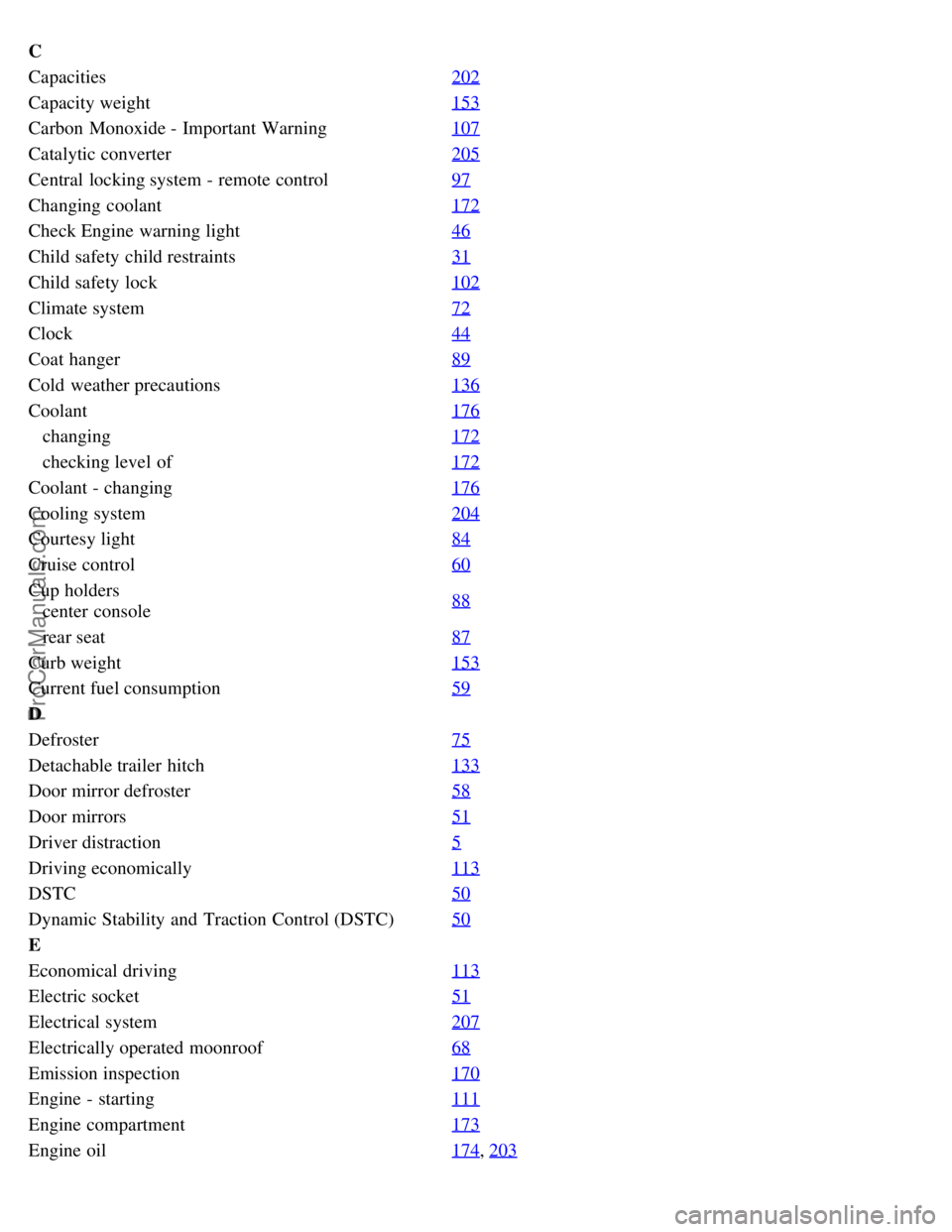
C
Capacities202
Capacity weight153
Carbon Monoxide - Important Warning107
Catalytic converter205
Central locking system - remote control97
Changing coolant172
Check Engine warning light46
Child safety child restraints31
Child safety lock102
Climate system72
Clock44
Coat hanger89
Cold weather precautions136
Coolant176
changing172
checking level of172
Coolant - changing176
Cooling system204
Courtesy light84
Cruise control60
Cup holders
center console88
rear seat
87
Curb weight153
Current fuel consumption59
D
Defroster75
Detachable trailer hitch133
Door mirror defroster58
Door mirrors51
Driver distraction5
Driving economically113
DSTC50
Dynamic Stability and Traction Control (DSTC)50
E
Economical driving113
Electric socket51
Electrical system207
Electrically operated moonroof68
Emission inspection170
Engine - starting111
Engine compartment173
Engine oil174, 203
ProCarManuals.com
Page 196 of 200
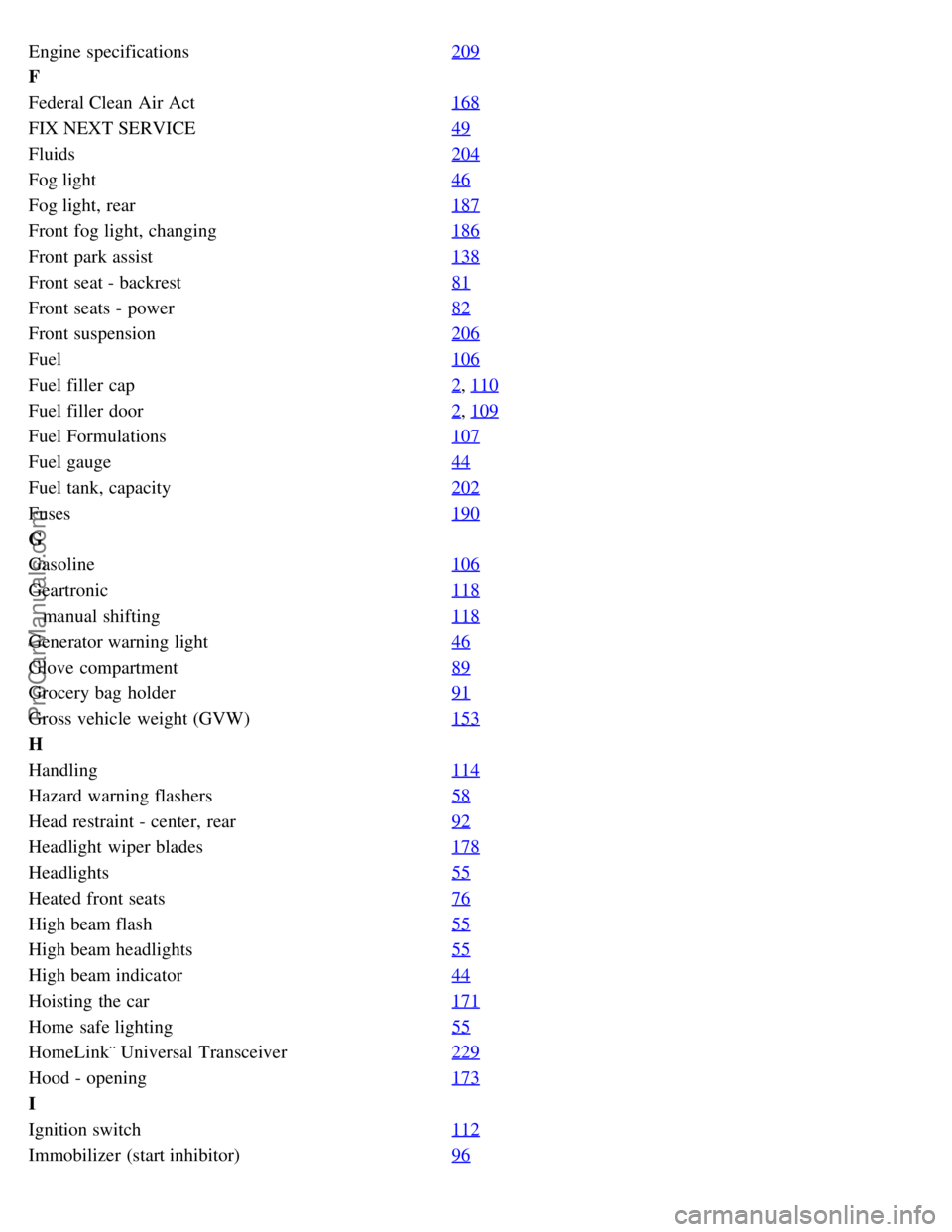
Engine specifications209
F
Federal Clean Air Act168
FIX NEXT SERVICE49
Fluids204
Fog light46
Fog light, rear187
Front fog light, changing186
Front park assist138
Front seat - backrest81
Front seats - power82
Front suspension206
Fuel106
Fuel filler cap2, 110
Fuel filler door2, 109
Fuel Formulations107
Fuel gauge44
Fuel tank, capacity202
Fuses190
G
Gasoline106
Geartronic118
manual shifting118
Generator warning light46
Glove compartment89
Grocery bag holder91
Gross vehicle weight (GVW)153
H
Handling114
Hazard warning flashers58
Head restraint - center, rear92
Headlight wiper blades178
Headlights55
Heated front seats76
High beam flash55
High beam headlights55
High beam indicator44
Hoisting the car171
Home safe lighting55
HomeLink¨ Universal Transceiver229
Hood - opening173
I
Ignition switch112
Immobilizer (start inhibitor)96
ProCarManuals.com
Page 199 of 200
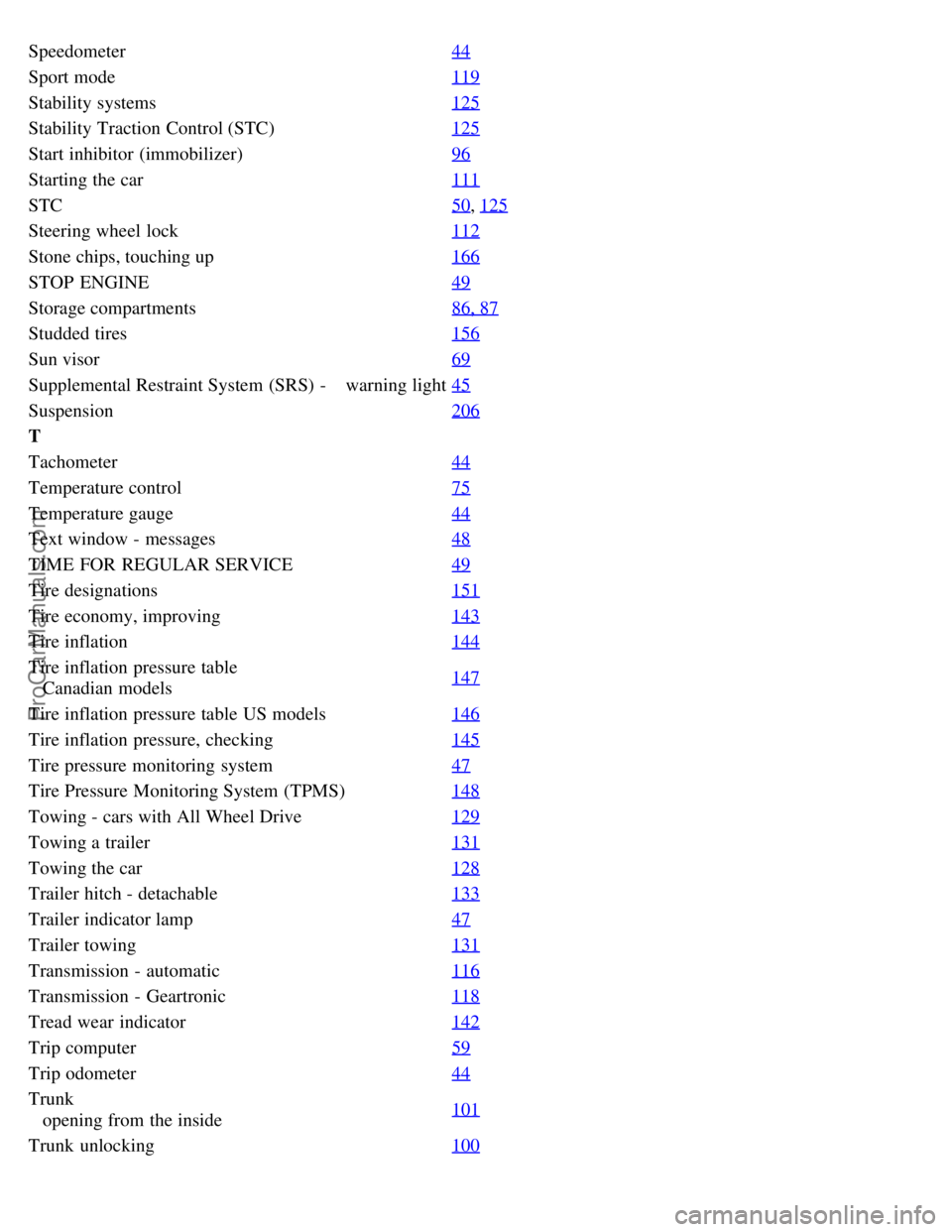
Speedometer44
Sport mode119
Stability systems125
Stability Traction Control (STC)125
Start inhibitor (immobilizer)96
Starting the car111
STC50, 125
Steering wheel lock112
Stone chips, touching up166
STOP ENGINE49
Storage compartments86, 87
Studded tires156
Sun visor69
Supplemental Restraint System (SRS) - warning light45
Suspension206
T
Tachometer44
Temperature control75
Temperature gauge44
Text window - messages48
TIME FOR REGULAR SERVICE49
Tire designations151
Tire economy, improving143
Tire inflation144
Tire inflation pressure table
Canadian models147
Tire inflation pressure table US models
146
Tire inflation pressure, checking145
Tire pressure monitoring system47
Tire Pressure Monitoring System (TPMS)148
Towing - cars with All Wheel Drive129
Towing a trailer131
Towing the car128
Trailer hitch - detachable133
Trailer indicator lamp47
Trailer towing131
Transmission - automatic116
Transmission - Geartronic118
Tread wear indicator142
Trip computer59
Trip odometer44
Trunk
opening from the inside101
Trunk unlocking
100
ProCarManuals.com